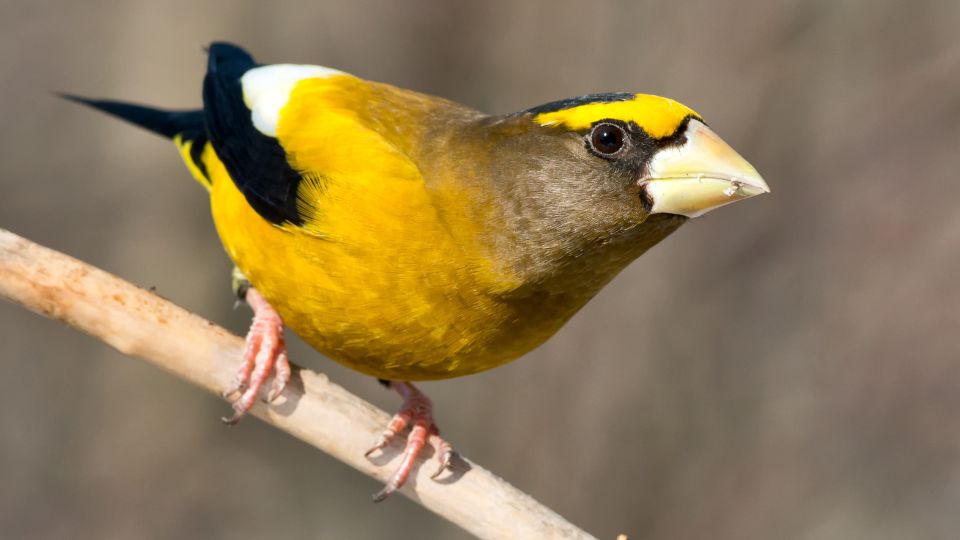The Evening Grosbeak, aka the Coccothraustes vespertinus, is a striking yellow, black, and white bird found primarily in Canada and North America. They are noted for their large conical bills (hence the french name Gros (thick) beak and bright yellow feathers.
Spotting an evening grosbeak is something rare and unique. Since the 1960s, their populations have been in decline. While most evening grosbeaks live year-round in northern parts of Canada, they can still be spotted during the breeding season in much of the United States and even Mexico. Keep reading to learn about this unique breed of Passeriformes and quick ways to spot them.
Over the years, evening grosbeaks sightings have been rare, their conservation status is in jeopardy due to cases of deforestation and disease. In the wild, Evening Grosbeaks can live up to 15 years, but many factors can reduce their longevity as a species. Identifying these rare birds and providing good food and shelter is a great way to help the declining population of these Passeriformes.
Evening Grosbeak Appearance
Evening grosbeaks have striking white, yellow and black coloring in their feathers. The male grosbeak has bright yellow feathers (similar to an American goldfinch) and yellow underparts. They have predominate black wings with white wing patches. The male grosbeak has a much brighter coloring than the female grosbeak.
On the other hand, females (and immature grosbeaks) have much more muted colors in their feathers. Female grosbeaks have feathers that are gray to mustard-colored yellow. They have black wings speckled with white patches and a sizable greenish beak that appears too large for its small head!
Overall, grosbeaks are bigger than a finch or sparrow but smaller than a robin. They have short tails and a wingspan of up to 36 centimeters. What’s interesting about evening grosbeak is that they have a large conical bill that is pale in color. Their pale bills stand out against their bright feathers, making them super easy to spot by birdwatchers at backyard bird-feeders.
Do Evening Grosbeaks Mate For Life?
Evening grosbeaks are monogamous but don’t mate for life. During mating season, the female selects her mating partner based on his song. If the female Grosbeak feels that the male Evening Grosbeak’s song is the most stunning of the other Grosbeaks, she selects him as her mate for the current breeding season.
However, the mating ritual doesn’t stop once the female decides upon a male. Once she has selected her forever mate, the male Grosbeak will select his lifetime partner after 1-2 days.
Evening Grosbeaks Nest & Eggs
These colorful songbirds like to build their nests high off of the ground. They prefer nesting sites high on the branches of deciduous and coniferous forests or in tall shrubs. They are year-round residents in colder climates such as Canada and migrate south to much of the United States and North America during the breeding season.
While they nest in forests from California to New York, it’s rare to see an evening grosbeak due to deforestation and population decline. It’s also important to note that they are irruptive migrants. Their breeding grounds are constantly shifting not due to instinct but rather in search of better food sources and nesting sites.
While you may notice evening grosbeaks in your backyard some years, changes in habitats may shift their migratory patterns away from your neighborhood permanently.
Evening Grosbeak eggs are primarily light blue to grayish blue. They are sprinkled with brown or purplish markings and measure .8 inches long and .6 inches wide. Their nest typically has between 2 to 5 eggs, and they raise 1-2 broods per season.

Evening Grosbeaks Nestlings and Juveniles
Baby evening grosbeaks live on a diet of mostly insects. While the parents live off a varied diet of bugs, sunflower seeds, berries, and nuts, evening grosbeaks feed their offspring protein-rich insects. They love the spruce budworm and other insects such as caterpillars, mealworms, and spiders.
At a glance, it’s challenging to tell female evening grosbeaks and juvenile evening grosbeaks apart. The female and juvenile have very similar muted-colored feathers with subtle hints of yellow. While adult male grosbeaks have bright yellow feathers, adolescent males have feathers with a mustard-yellow coloring and pale conical bills.
Where are Evening Grosbeaks most common?
Evening grosbeaks are most common in the Northern parts of Canada. Their populations are more abundant in colder parts of Northern Canada and become scarce as you travel south. While grosbeaks appear in most parts of the United States during the breeding season, sightings are becoming rare.
While they prefer the cooler climates of Canada, some bird sightings have been found as far south as Mexico, although this is considered very rare.

Why are they called Evening Grosbeaks?
The term grosbeak is French. Gros translates thick, which breaks down to ‘thick beak.’ It makes sense since Grosbeaks have a very thick and easily distinguishable beak. Simple enough. So, where does the term evening come from? It’s likely due to a simple misunderstanding that stuck.
Henry Schoolcraft, the man who first noticed the unusual specimen of Grosbeak in the 1820s, heard its unique song around sunset. While grosbeaks sang all day, it was the time of day that he noticed the bird’s call that led him to refer to it as an evening grosbeak.
What is Their Conservation Status?
In recent years, the population of evening grosbeak has been in constant decline since the mid-1960s. Starting in the 1960s, the population of the evening grosbeak has declined by a staggering 74 percent. Today, there are roughly 3.8 million breeding evening gGrosbeaks worldwide, and that number is steadily declining.
According to the Continental Concern Score, the evening grosbeak is listed at 13 out of 20 (moderate concern) as a bird that is becoming endangered. With continued threats to their habitats, they are on the cusp of transitioning from a moderate threat to a high threat in upcoming years if protective measures aren’t implemented.
What are the main threats to Evening Grosbeaks?
Deforestation, the logging industry, climate change, and chemical pest control are just a few reasons the Evening Grosbeak is at risk of becoming endangered. One of the most significant reasons for their decline is the destruction of their habitats.
The logging industry and the deforestation of boreal forests continue to eat away at their breeding grounds. Some populations are on the decline due to disease, while other aspects may include aerial spraying as pest control.

